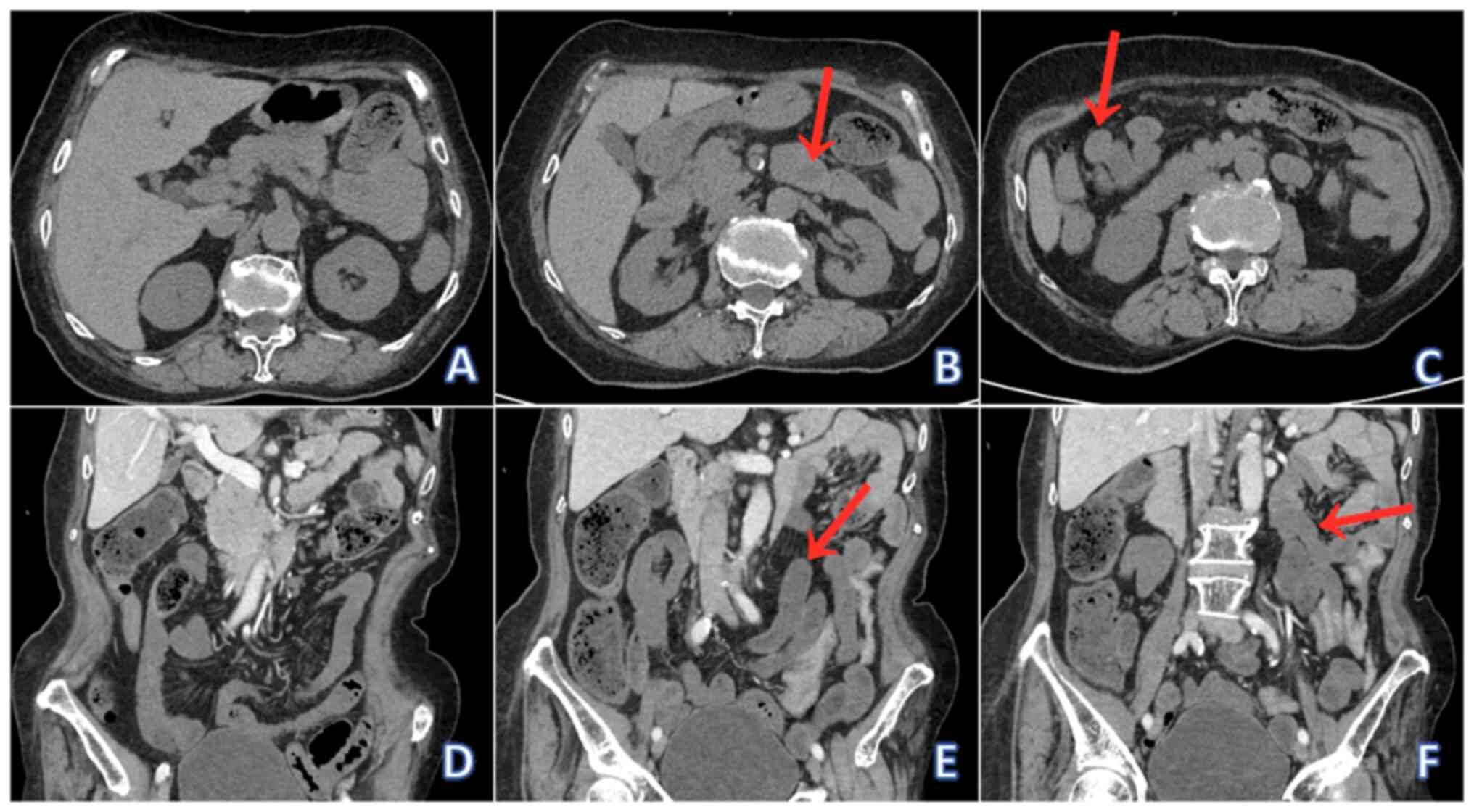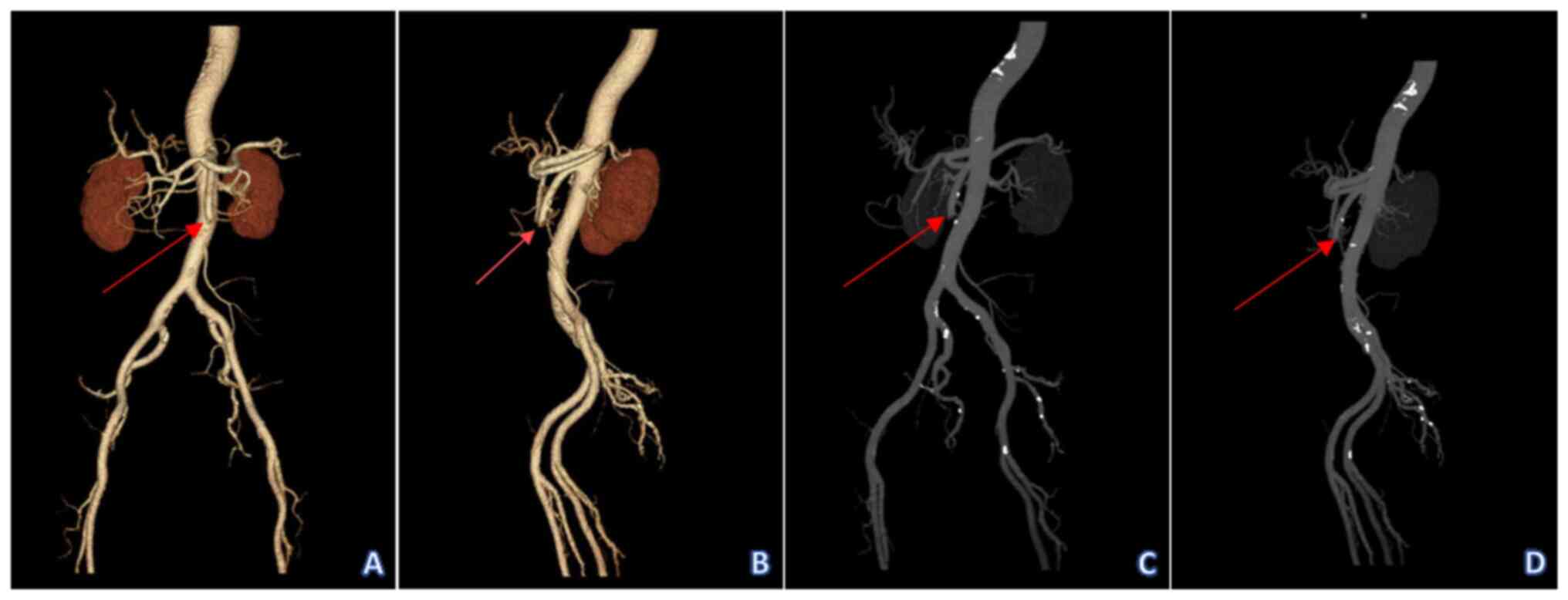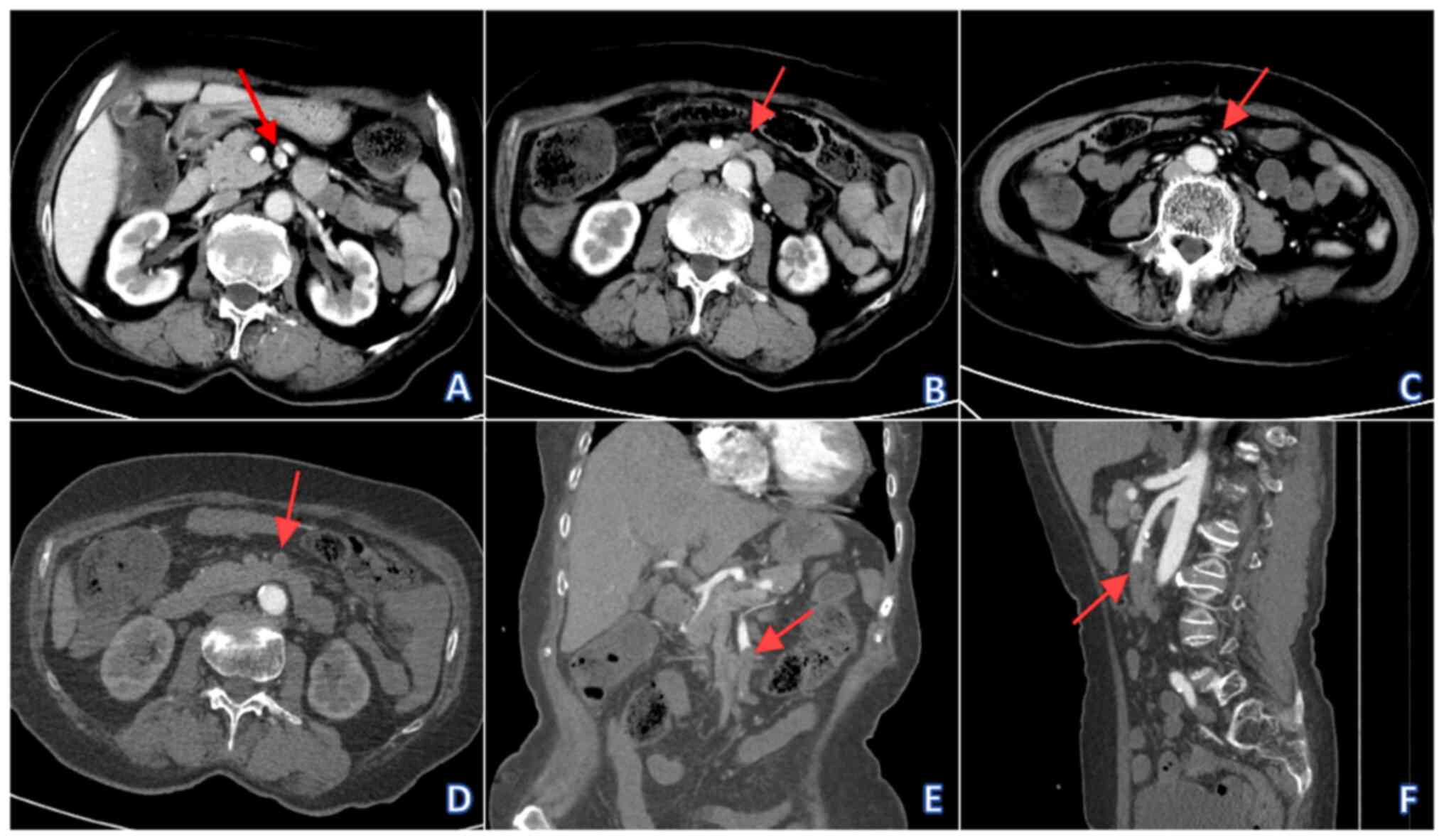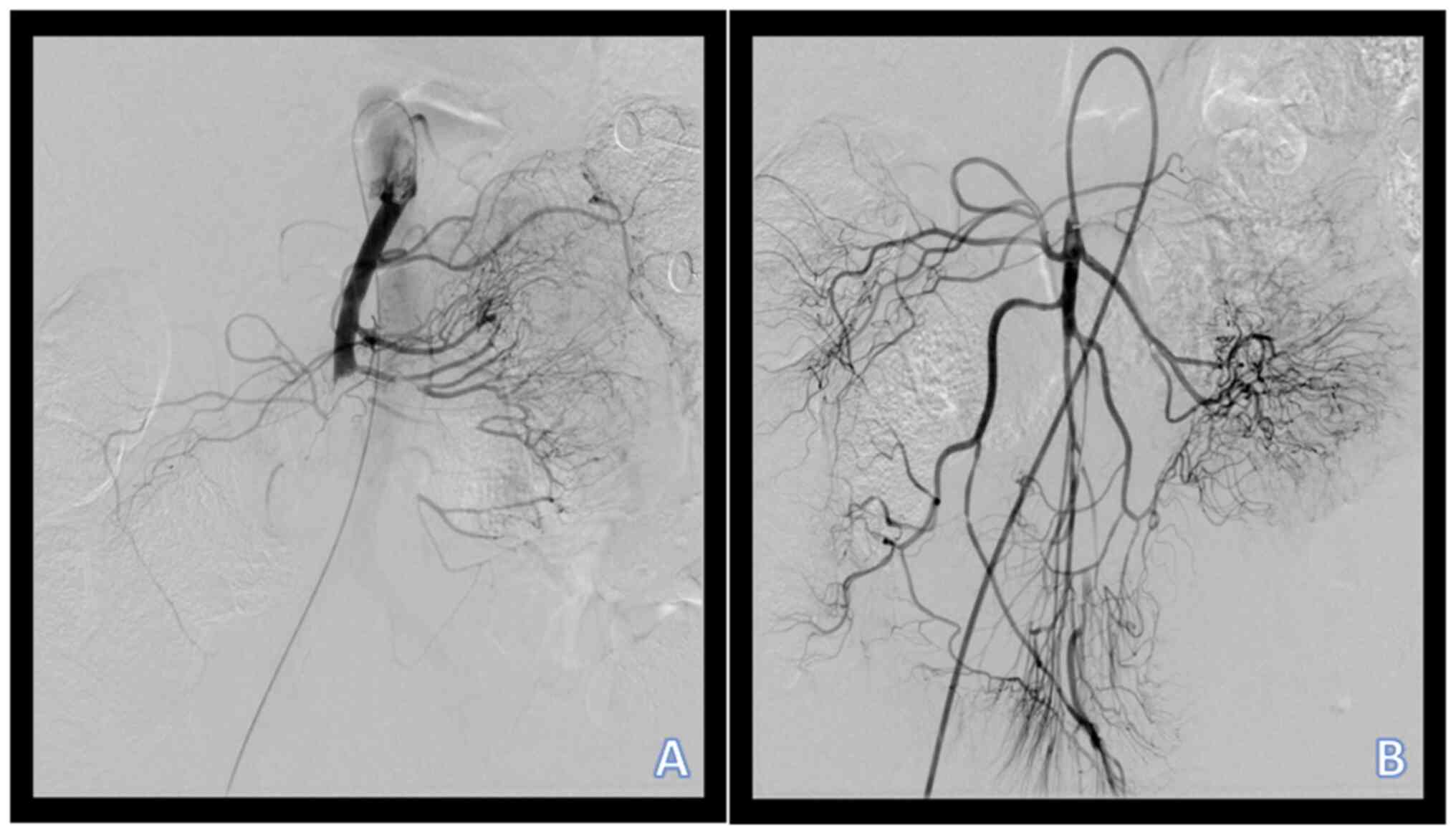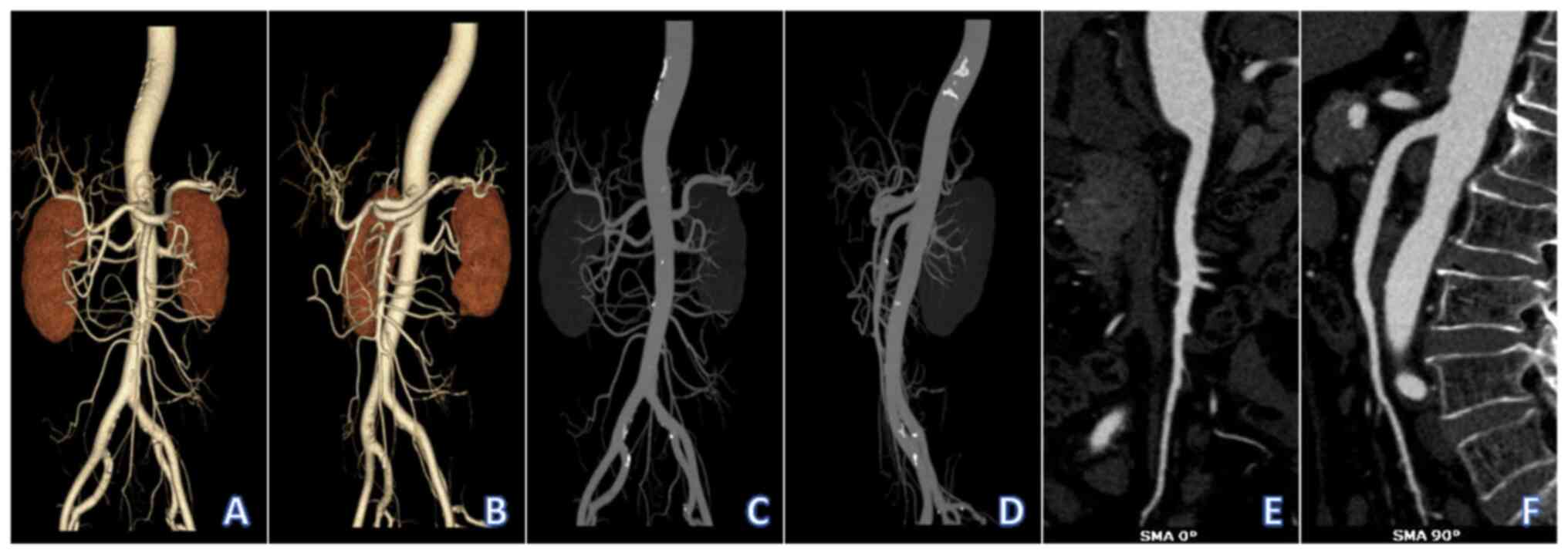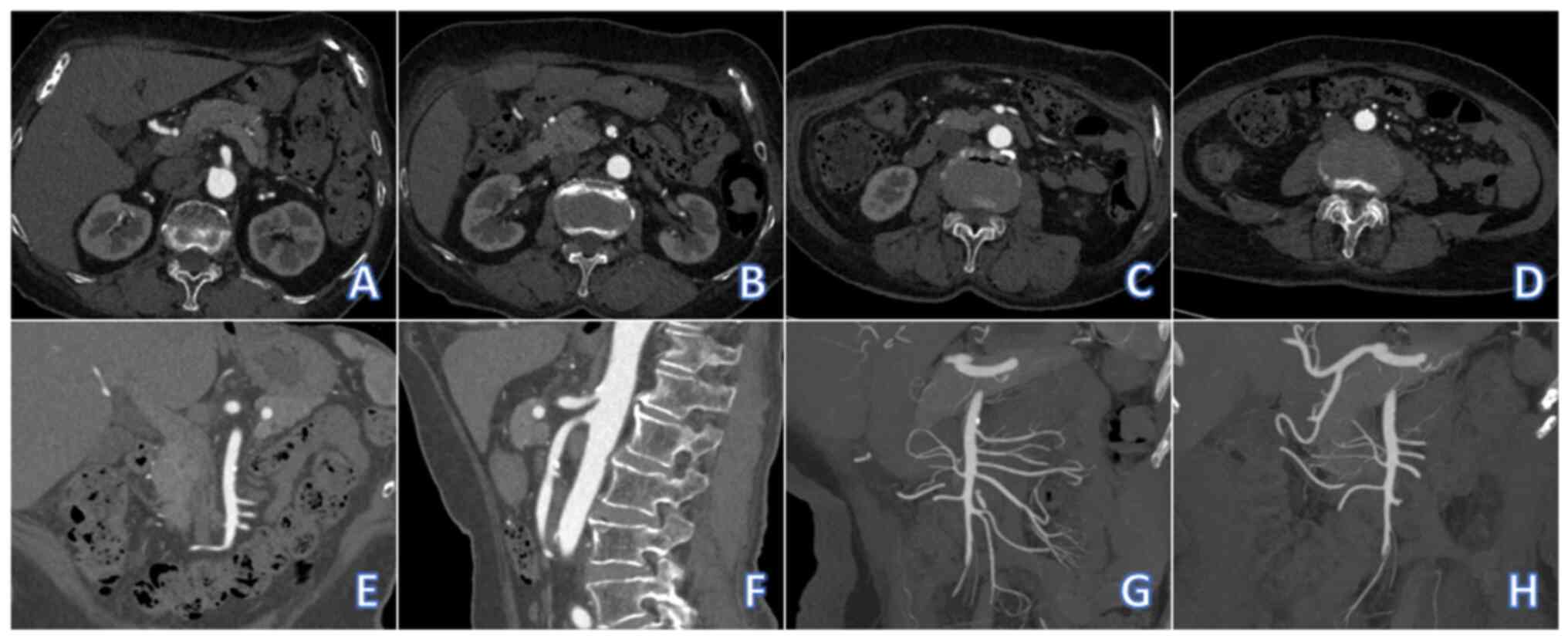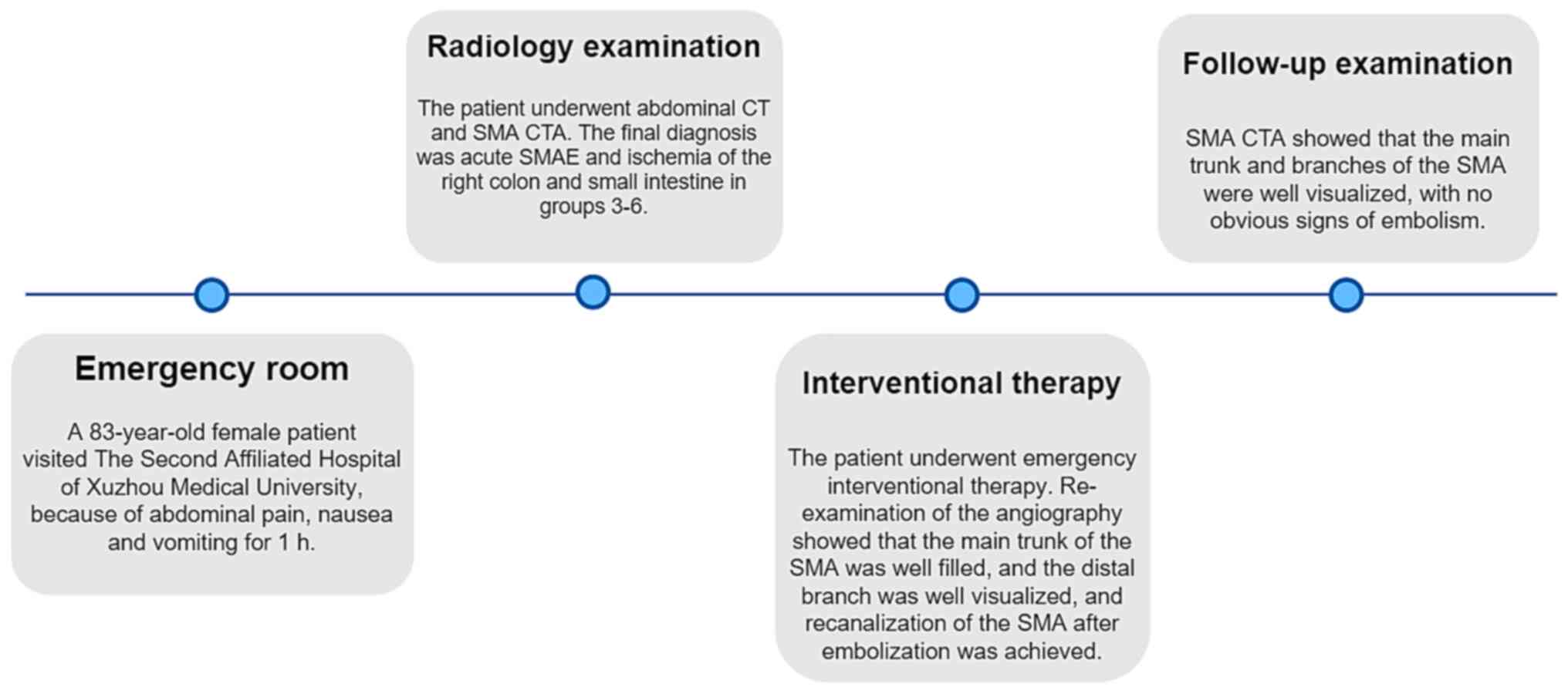|
1
|
Xu R, Tang L, Qin S, Zhang S and Wang M:
Percutaneous mechanical thrombectomy using the AcoStream thrombus
aspiration system for acute superior mesenteric artery embolism.
Ann Vasc Surg. 106:264–272. 2024.PubMed/NCBI View Article : Google Scholar
|
|
2
|
Kerdiles T and Gras J: Superior mesenteric
artery syndrome. N Engl J Med. 389(359)2023.PubMed/NCBI View Article : Google Scholar
|
|
3
|
Balcerzak A, Tubbs RS,
Waśniewska-Włodarczyk A, Rapacka E and Olewnik Ł: Classification of
the superior mesenteric artery. Clin Anat. 35:501–511.
2022.PubMed/NCBI View
Article : Google Scholar
|
|
4
|
Jing Y, Xu J, Chen B, Xia D, Xia D, Tian
Y, Xia W, Lu C and Wu Y: Superior mesenteric artery embolism after
radiofrequency ablation in regularly anticoagulated patients with
paroxysmal atrial fibrillation: A case report. BMC Cardiovasc
Disord. 23(56)2023.PubMed/NCBI View Article : Google Scholar
|
|
5
|
Zhang Z, Chen X, Li C, Feng H, Yu H and
Zhu R: Percutaneous mechanical thrombectomy for acute superior
mesenteric artery embolism: Preliminary experience in five cases.
Ann Vasc Surg. 63:186–192. 2020.PubMed/NCBI View Article : Google Scholar
|
|
6
|
Du R, Zhang J, Chang Y and Liu Y: A case
of acute superior mesenteric artery embolism caused by constipation
after hemorrhoid surgery. Asian J Surg. 45:2420–2422.
2022.PubMed/NCBI View Article : Google Scholar
|
|
7
|
Yun WS, Lee KK, Cho J, Kim HK and Huh S:
Treatment outcome in patients with acute superior mesenteric artery
embolism. Ann Vasc Surg. 27:613–620. 2013.PubMed/NCBI View Article : Google Scholar
|
|
8
|
Yang JS, Xu ZY, Chen FX, Wang MR, Cong RC,
Fan XL, He BS and Xing W: Role of clinical data and multidetector
computed tomography findings in acute superior mesenteric artery
embolism. World J Clin Cases. 10:4020–4032. 2022.PubMed/NCBI View Article : Google Scholar
|
|
9
|
Yu Z, Hu J and Lang D: Pseudoaneurysm as a
rare complication in the treatment of superior mesenteric artery
embolism via percutaneous mechanical thrombectomy: A case report. J
Int Med Res. 49(3000605211022941)2021.PubMed/NCBI View Article : Google Scholar
|
|
10
|
Barakate MS, Cappe I, Curtin A, Engel KD,
Li-Kim-Moy J, Poon MS and Sandeman MD: Management of acute superior
mesenteric artery occlusion. ANZ J Surg. 72:25–29. 2002.PubMed/NCBI View Article : Google Scholar
|
|
11
|
Zhang YR, Li ZY, Liang J, Bai S and Zhang
ZF: Diagnostic value of mesenteric CTA combined with D-dimer level
and inflammatory factor changes in severity of mesenteric artery
embolism. Pak J Med Sci. 39:1321–1325. 2023.PubMed/NCBI View Article : Google Scholar
|
|
12
|
Liao G, Chen S, Cao H, Wang W and Gao Q:
Review: Acute superior mesenteric artery embolism: A vascular
emergency cannot be ignored by physicians. Medicine (Baltimore).
98(e14446)2019.PubMed/NCBI View Article : Google Scholar
|
|
13
|
Chinsakchai K, Wongwanit C, Ruangsetakit C
and Mutirangura P: Successful treatment in superior mesenteric
artery embolism: A case report and literature review. J Med Assoc
Thai. 93:739–744. 2010.PubMed/NCBI
|
|
14
|
Wang B, Sun R, Chen W and Li T:
Enlightenment and lesson from the successful treatment of acute
superior mesenteric artery embolism. Cell Mol Biol
(Noisy-le-grand). 63:23–27. 2017.PubMed/NCBI View Article : Google Scholar
|
|
15
|
Sato O, Okamoto H and Matsumoto H:
Emergency CT scan for the diagnosis of superior mesenteric artery
embolism. Report of 2 cases. Int Angiol. 22:438–440.
2003.PubMed/NCBI
|
|
16
|
Tsuda M, Nakamura M, Yamada Y, Saito H,
Ishibashi T and Takahashi S: Acute superior mesenteric artery
embolism: Rapid reperfusion with hydrodynamic thrombectomy and
pharmacological thrombolysis. J Endovasc Ther. 10:1015–1018.
2003.PubMed/NCBI View Article : Google Scholar
|
|
17
|
Sagris M, Vardas EP, Theofilis P,
Antonopoulos AS, Oikonomou E and Tousoulis D: Atrial fibrillation:
Pathogenesis, predisposing factors, and genetics. Int J Mol Sci.
23(6)2021.PubMed/NCBI View Article : Google Scholar
|
|
18
|
Cloete L: Diabetes mellitus: An overview
of the types, symptoms, complications and management. Nurs Stand.
37:61–66. 2022.PubMed/NCBI View Article : Google Scholar
|
|
19
|
Wang H, Xiao X, Zhang W, Ma Z, Zhang JL,
Tang L and Yang X: Imaging of acute superior mesenteric artery
embolus using spectral CT in a canine model. Br J Radiol.
88(20150296)2015.PubMed/NCBI View Article : Google Scholar
|
|
20
|
Simó G, Echenagusia AJ, Camúñez F,
Turégano F, Cabrera A and Urbano J: Superior mesenteric arterial
embolism: Local fibrinolytic treatment with urokinase. Radiology.
204:775–779. 1997.PubMed/NCBI View Article : Google Scholar
|
|
21
|
Wang G, Lu W, Xia Q, Mao B, Wang L, Li T
and Jiang L: Superior mesenteric arterial embolism: A retrospective
study of local thrombolytic treatment with urokinase in West China.
Int J Clin Pract. 57:588–591. 2003.PubMed/NCBI
|
|
22
|
Franchini M, Focosi D, Pezzo MP and
Mannucci PM: How we manage a high D-dimer. Haematologica.
109:1035–1045. 2024.PubMed/NCBI View Article : Google Scholar
|
|
23
|
Halaby R, Popma CJ, Cohen A, Chi G,
Zacarkim MR, Romero G, Goldhaber SZ, Hull R, Hernandez A, Mentz R,
et al: D-Dimer elevation and adverse outcomes. J Thromb
Thrombolysis. 39:55–59. 2015.PubMed/NCBI View Article : Google Scholar
|
|
24
|
Sinha D, Kale S, Kundaragi NG and Sharma
S: Mesenteric ischemia: A radiologic perspective. Abdom Radiol
(NY). 47:1514–1528. 2022.PubMed/NCBI View Article : Google Scholar
|
|
25
|
Sugiyama C, Akai A, Yamakita N, Yasuda K
and Ihara N: Rupture of pancreaticoduodenal artery aneurysm caused
by superior mesenteric artery embolism. Am J Gastroenterol.
103:1841–1842. 2008.PubMed/NCBI View Article : Google Scholar
|
|
26
|
Heiss P, Loewenhardt B, Manke C, Hellinger
A, Dietl KH, Schlitt HJ, Scheibl K, Feuerbach S and Paetzel C:
Primary percutaneous aspiration and thrombolysis for the treatment
of acute embolic superior mesenteric artery occlusion. Eur Radiol.
20:2948–2958. 2010.PubMed/NCBI View Article : Google Scholar
|
|
27
|
Luan JY, Guan X, Li X, Wang CM, Li TR,
Zhang L and Han JT: Isolated superior mesenteric artery dissection
in China. J Vasc Surg. 63:530–536. 2016.PubMed/NCBI View Article : Google Scholar
|
|
28
|
Anil G, Wee-Thong N and Ashley Robless P:
Short bowel syndrome after endovascular recanalization of superior
mesenteric artery embolic occlusion: A rare event. J Vasc Interv
Radiol. 23:1709–1711. 2012.PubMed/NCBI View Article : Google Scholar
|
|
29
|
Alkhader A, Saleh N, Mansour MM, Hussein O
and Saad B: Expect the unexpected: A rare case of isolated superior
mesenteric artery vasculitis. Cureus. 15(e40106)2023.PubMed/NCBI View Article : Google Scholar
|
|
30
|
Haymet AB, Lee D, Ho-Shon K and Waugh R:
When the conventional treatment fails: A rare approach to superior
mesenteric arterial embolization. Vasc Endovascular Surg.
54:169–171. 2020.PubMed/NCBI View Article : Google Scholar
|
|
31
|
Xu X, Eubanks AL, Wladis A, Veldhuis P and
Eubanks S: Mycotic superior mesenteric artery aneurysm: Case report
and literature review. Surg Innov. 26:260–264. 2019.PubMed/NCBI View Article : Google Scholar
|
|
32
|
Calin GA, Calin S, Ionescu R, Croitoru M,
Diculescu M and Oproiu A: Successful local fibrinolytic treatment
and balloon angioplasty in superior mesenteric arterial embolism: A
case report and literature review. Hepatogastroenterology.
50:732–734. 2003.PubMed/NCBI
|
|
33
|
Ikeda A, Yamada S, Ishizaka R, Sakurai K,
Takatsuka D, Takaichi M, Fujiwara K and Noguchi M: Non-obstructive
mesenteric ischaemia during drug therapy for maxillary cancer: A
case report. Biomed Rep. 21(172)2024.PubMed/NCBI View Article : Google Scholar
|
|
34
|
Bourcier S, Klug J and Nguyen LS:
Non-occlusive mesenteric ischemia: Diagnostic challenges and
perspectives in the era of artificial intelligence. World J
Gastroenterol. 27:4088–4103. 2021.PubMed/NCBI View Article : Google Scholar
|
|
35
|
Kim YW, Choi HC, Yang WJ, Koo BJ, Ahn JK,
Lee JP, Na JB, Jo SH, Park SE and Won JH: Microcatheter-directed
thrombolysis using recombinant tissue plasminogen activator for the
treatment of acute superior mesenteric artery embolism: A case
report. Medicina (Kaunas). 59(1889)2023.PubMed/NCBI View Article : Google Scholar
|
|
36
|
Blessing E, Rottbauer W, Mereles D, Hosch
W, Benz A, Friess H, Autschbach F, Müller M, Stremmel W and Katus
H: Isolated left ventricular noncompaction of the myocardium as a
cause of embolic superior mesenteric artery occlusion. J Am Soc
Echocardiogr. 18(693)2005.PubMed/NCBI View Article : Google Scholar
|
|
37
|
Nakayama T, Nakamura Y, Niitsuma K,
Ushijima M, Yasumoto Y, Kuroda M, Nakamae K, Minamidate N, Hayashi
Y, Tsuruta R, et al: Totally thoracoscopic atrial fibrillation
surgery following massive small bowel resection due to superior
mesenteric artery embolization: Report of two cases. Surg Case Rep.
10(141)2024.PubMed/NCBI View Article : Google Scholar
|
|
38
|
Ahue KHN, Goho KM, Adon AA, Coulibaly NA,
Kpan KJ and Keita M: Bifocal bowel obstruction by synchronous
transverse and sigmoid colon volvulus: A case report and
qualitative review of the literature. Int J Surg Case Rep.
123(110312)2024.PubMed/NCBI View Article : Google Scholar
|
|
39
|
Xu Q, Wang Y, Xu B, Lang D and Lin Z:
Efficacy and safety analysis of AcoStream thrombus aspiration
device in the treatment of acute superior mesenteric artery
embolism. Vascular. (17085381241240865)2024.PubMed/NCBI View Article : Google Scholar : (Epub ahead of
print).
|



